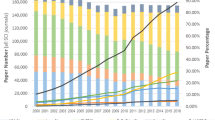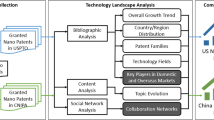Abstract
This paper investigates the global nanotechnology and nanoscience (NN) indicators in a developmental context, during three 5-year periods from 2000 to 2014. Through bibliometric analyses of the longitudinal data from well-known databases, the growth patterns of NN articles and patents were investigated. Furthermore, the causal relationships among these indicators and some characteristics of the 105 countries studied were examined using regression and correlation analyses leading to the identification of the top 20 “science and innovation giants,” in terms of all indicators, as well as the existence of significant, yet different, correlations among the indicators in developing and developed countries. In general, China’s growth rate (GR) in NN publications was found to surpass USA, from 2010 to 2014, leading to a change in the ranking of the top countries and moving China, with about 25 % of world’s NN articles, to top. A different trend was distinguished for patents in the area of nanotechnology, where USA, as the origin of over half of the world’s granted patents, has been the undisputed leader. The shares of developing countries (i.e., the percent ratios of the number of nanotech patents granted to the citizens of developing countries over the total number of nanotech patents granted worldwide) was found to be incompatible with the countries’ shares in the total NN articles, indicating a poor correlation between the two factors. However, developing countries were found to be superior in the GR of both NN articles and patents. Finally, the top countries identified can be regarded as suitable for comparative studies, and benchmarking by researchers and policy makers.






Similar content being viewed by others
References
Alibolandi M, Abnous K, Sadeghi F, Hosseinkhani H, Ramezani M, Hadizadeh F (2016) Folate receptor-targeted multimodal polymersomes for delivery of quantum dots and doxorubicin to breast adenocarcinoma: in vitro and in vivo evaluation. Int J Pharm 500(1–2):162–178
Bajwa R, Yaldram K, Rafique S (2013) A scientometric assessment of research output in nanoscience and nanotechnology: Pakistan perspective. Scientometrics 94(1):333–342
Bassecoulard E, Lelu A, Zitt M (2007) Mapping nanosciences by citation flows: a preliminary analysis. Scientometrics 70(3):859–880
Beise M, Stahl H (1999) Public research and industrial innovations in Germany. Res Policy 28(4):397–422
Bhushan B (2010) Springer handbook of nanotechnology. Springer Science & Business Media, New York.
Chen H, Roco M, Son J, Jiang S, Larson C, Gao Q (2013) Global nanotechnology development from 1991 to 2012: patents, scientific publications, and effect of NSF funding. J Nanopart Res 15(9):1–21
Choi S, Yang J, Park H (2015) Quantifying the Triple Helix relationship in scientific research: statistical analyses on the dividing pattern between developed and developing countries. Qual Quant 49(4):1381–1396
French B, Heagerty PJ (2008) Analysis of longitudinal data to evaluate a policy change. Stat Med 27(24):5005–5025
Geuna A, Nesta LJJ (2006) University patenting and its effects on academic research: the emerging European evidence. Res Policy 35(6):790–807
Gholivand MB, Mohammadi-Behzad L, Hosseinkhani H (2016) Application of a Cu–chitosan/multiwalled carbon nanotube film-modified electrode for the sensitive determination of rutin. Anal Biochem 493:35–43
Gorjiara T, Baldock C (2014) Nanoscience and nanotechnology research publications: a comparison between Australia and the rest of the world. Scientometrics 100(1):121–148
Grimm H, Jaenicke J (2015) Testing the causal relationship between academic patenting and scientific publishing in Germany: Crowding-out or reinforcement? J Technol Transf 40(3):512–535
Guan J, Liu N (2014) Measuring scientific research in emerging nano-energy field. J Nanopart Res 16(4):1–15
Han HC, Lo HC, Wu CY, Chen KH, Chen LC, Ou KL, Hosseinkhani H (2015) Nano-textured fluidic biochip as biological filter for selective survival of neuronal cells. J Biomed Mater Res Part A 103(6):2015–2023
Hirsch JE (2005) An index to quantify an individual’s scientific research output. Proc Natl Acad Sci USA 102(46):16569–16572
Hollander M, Wolfe D, Chicken E (2013) Nonparametric statistical methods. Wiley, New York
Huang Z, Chen H, Yan L, Roco M (2005) Longitudinal nanotechnology development (1991–2002): national science foundation funding and its impact on patents. J Nanopart Res 7(4–5):343–376
Huang C, Notten A, Rasters N (2011) Nanoscience and technology publications and patents: a review of social science studies and search strategies. J Technol Transf 36(2):145–172
Jiang S, Gao Q, Chen H, Roco MC (2015) The roles of sharing, transfer, and public funding in nanotechnology knowledge-diffusion networks. J Assoc Inform Sci Technol 66(5):1017–1029
Karpagam R, Gopalakrishnan S, Ramesh Babu B (2011) Mapping of nanoscience and nanotechnology research in India: a scientometric analysis, 1990–2009. Scientometrics 89(2):501–522
Li X, Lin Y, Chen H, Roco M (2007) Worldwide nanotechnology development: a comparative study of USPTO, EPO, and JPO patents (1976–2004). J Nanopart Res 9(6):977–1002
Liu X, Zhang P, Li X, Chen H, Dang Y, Larson C et al (2009) Trends for nanotechnology development in China, Russia, and India. J Nanopart Res 11(8):1845–1866
Maghrebi M, Abbasi A, Amiri S, Monsefi R, Harati A (2011) A collective and abridged lexical query for delineation of nanotechnology publications. Scientometrics 86(1):15–25
Mahapatra M (1985) On the validity of the theory of exponential growth of scientific literature. In Proceedings of the 15th IASLIC conference, Bangalore (pp. 61–70)
Miyazaki K, Islam N (2007) Nanotechnology systems of innovation—an analysis of industry and academia research activities. Technovation 27(11):661–675
Molinari A, Molinari JF (2008a) Mathematical aspects of a new criterion for ranking scientific institutions based on the H-index. Scientometrics 75(2):339–356
Molinari JF, Molinari A (2008b) A new methodology for ranking scientific institutions. Scientometrics 75(1):163–174
Mottaghitalab F, Farokhi M, Shokrgozar MA, Atyabi, Hosseinkhani H (2015) Silk fibroin nanoparticle as a novel drug delivery system. J Controlled Release 206:161–176
Reiss T, Dominguez Lacasa I (2008) The performance of European countries in biotechnology: how does Europe compare to the USA? Int J Biotechnol 10(4):303–326
Roco MC, Bainbridge WS (2005) Societal implications of nanoscience and nanotechnology: maximizing human benefit. J Nanopart Res 7(1):1–13
Sastry K, Rashmi HB, Rao NH (2010) Nanotechnology patents as R&D indicators for disease management strategies in agriculture. J Intellect Prop Rights 15:197–205
Soltani A, Tabatabaeian S, Hanafizadeh P, Bamdad Soofi J (2011) An evaluation scheme for nanotechnology policies. J Nanopart Res 13(12):7303–7312
Wang J, Shapira P (2011) Funding acknowledgement analysis: an enhanced tool to investigate research sponsorship impacts: the case of nanotechnology. Scientometrics 87(3):563–586
Acknowledgments
The authors are very grateful for the valuable comments and suggestions provided by the anonymous reviewers. The authors also wish to thank the editor of the journal for his careful cooperation in the review process of the article, which significantly improved the quality of the paper. We are also very thankful for the precise proofreading and noteworthy recommendations of Dr. Morteza Rezapour, which helped us significantly and enhanced the comprehensibility of paper.
Author information
Authors and Affiliations
Corresponding author
Appendix
Appendix
Search string used for retrieving NN-related publications and patents (Maghrebi et al. 2011) (nano* not nano2 not nano3 not nanog not nanosecond* not nanomol* not nanogram* not nanoplankton* or "atom* scale" or "atomic layer deposition*" or "giant magnetoresist*" or graphen* or dendrimer* or fulleren* or "c-60" or "langmuir blodgett*" or mesopor* or "molecul* assembl*" or "molecul* wire*" or "porous silicon*" or "quantum dot*" or "quantum well*" or "quantum comput*" or "quantum wire*" or qubit* or "self assembl*" or supramolecul* or supermolecul* or "ultrathin film*" or "ultra thin film*").
Rights and permissions
About this article
Cite this article
Jafari, M., Zarghami, H.R. Measuring nanotechnology development through the study of the dividing pattern between developed and developing countries during 2000–2014. J Nanopart Res 18, 180 (2016). https://doi.org/10.1007/s11051-016-3431-0
Received:
Accepted:
Published:
DOI: https://doi.org/10.1007/s11051-016-3431-0




